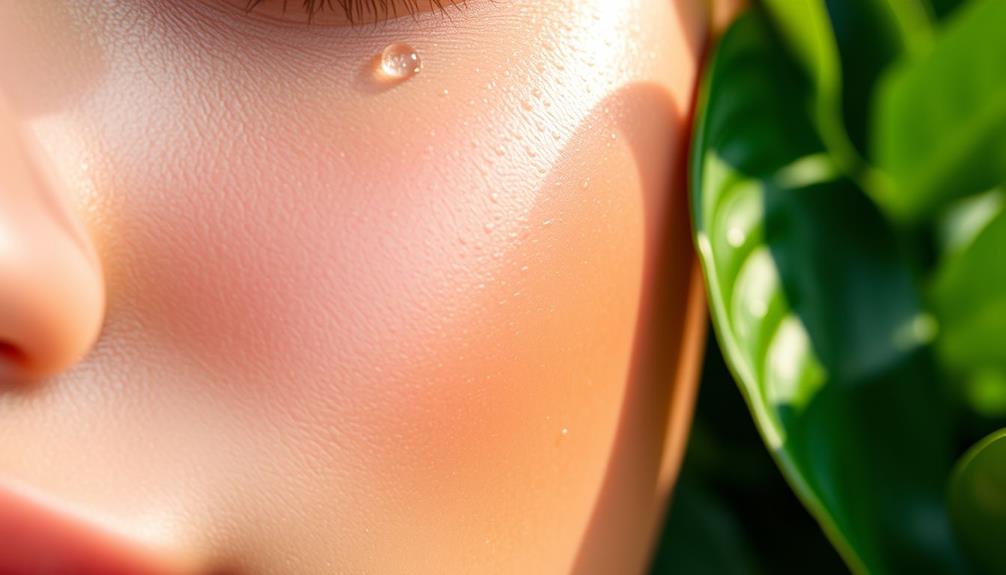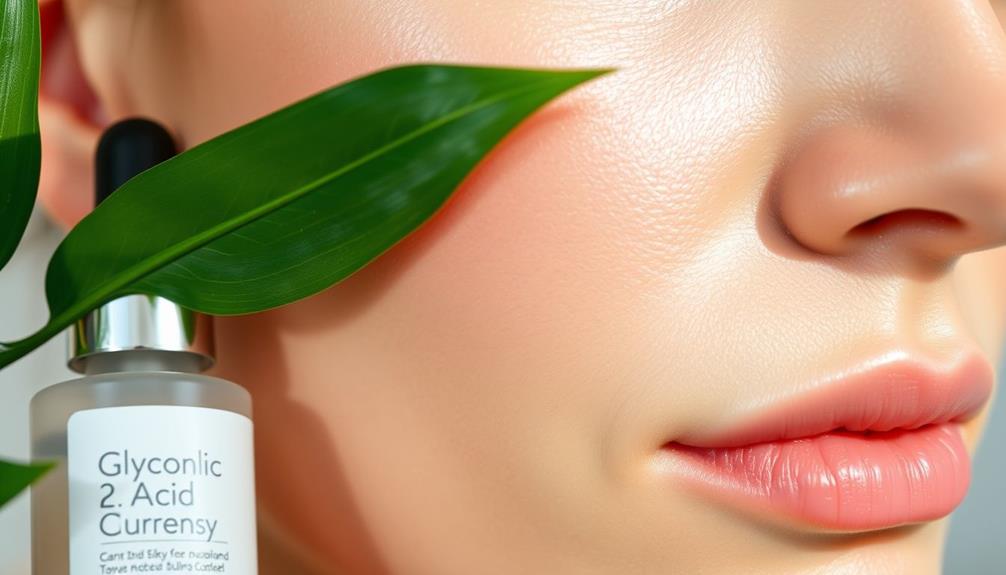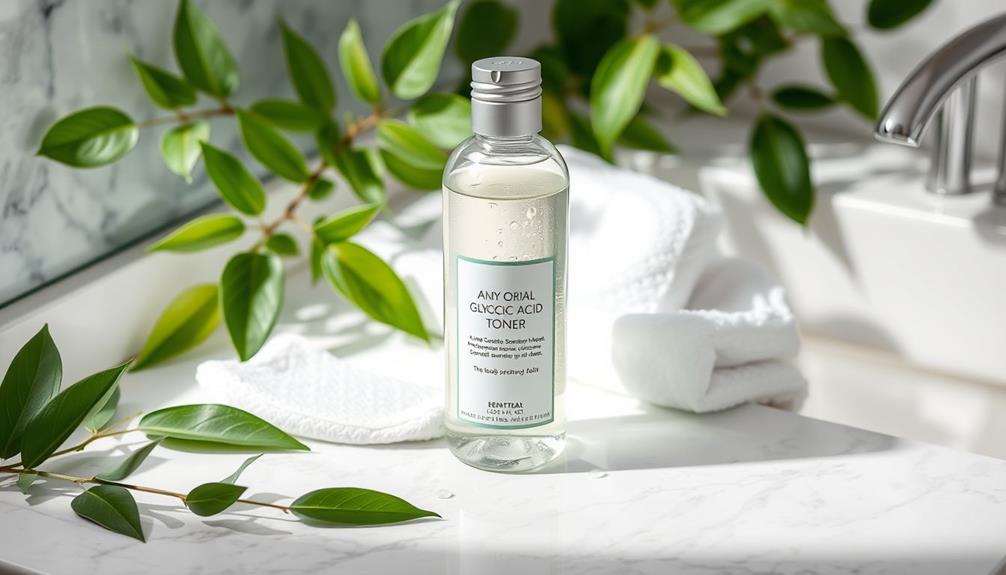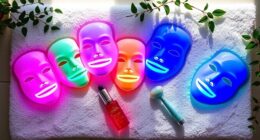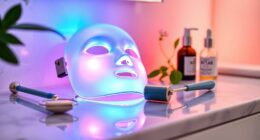Glycolic acid is a powerful alpha-hydroxy acid derived from sugarcane that you really need in your skincare routine. It works wonders by gently exfoliating dead skin cells, promoting faster cell turnover, and improving your skin's texture. With regular use, it helps reduce acne visibility and fades dark spots, giving you a more even complexion. Plus, it attracts moisture, keeping your skin hydrated and supple. Most people can start with a low concentration, using it a few times a week, and with some care, you'll see fantastic results. Keep exploring to discover how glycolic acid can transform your skin!
Key Takeaways
- Glycolic acid is a powerful AHA that exfoliates the skin, promoting a smoother texture and faster cell turnover.
- It hydrates skin by attracting moisture, improving absorption of moisturizers, and maintaining elasticity through collagen stimulation.
- Effective for acne treatment, glycolic acid unclogs pores, reduces breakouts, and fades hyperpigmentation for an even skin tone.
- Start with a low concentration (around 5%) and gradually increase to minimize irritation while monitoring skin response.
What Is Glycolic Acid?
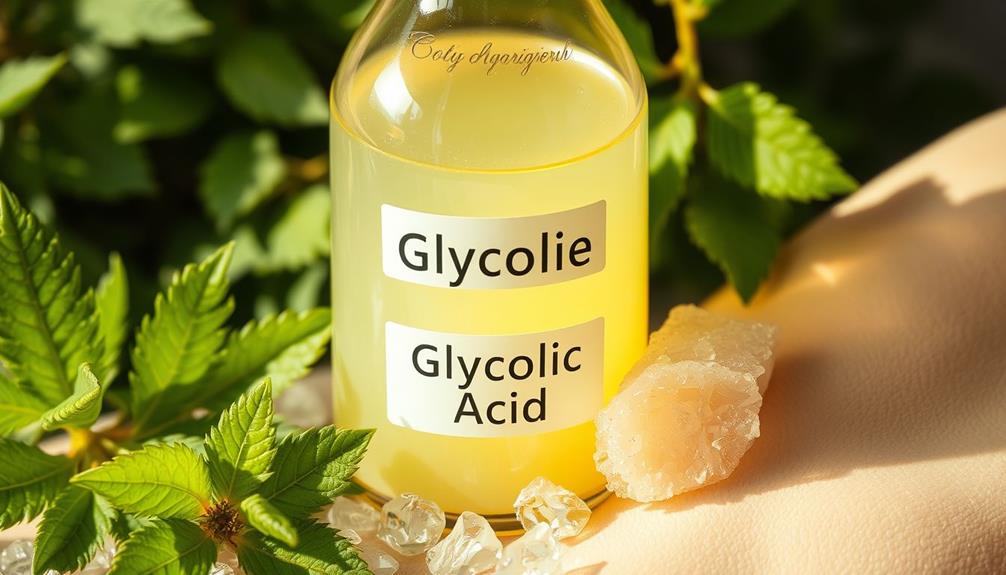
Glycolic acid is a powerful alpha-hydroxy acid (AHA) derived from sugarcane that penetrates deeply into your skin to promote smoother texture and faster cell turnover.
As a chemical exfoliant, it works by dissolving the bonds between dead skin cells, making it an effective solution for various skin concerns like acne and pigmentation. By increasing cell turnover, glycolic acid helps reveal fresher, more radiant skin beneath.
Additionally, incorporating natural ingredients such as essential oils can further enhance your skincare routine, providing benefits like improved hydration and relaxation through essential oils for relaxation.
You'll find glycolic acid in many skincare products, from cleansers to serums, tailored to address specific needs. Regular use can enhance your skin texture, improving overall clarity and tone.
For those seeking more intensive results, higher concentrations of glycolic acid are often used in professional chemical peels, offering a deeper exfoliation that rejuvenates your skin.
Not only does glycolic acid tackle issues like acne and signs of aging, but it also boosts skin radiance by promoting a more even skin tone.
Incorporating this versatile AHA into your routine can lead to visible improvements, making it a go-to ingredient for anyone looking to elevate their skincare game.
Benefits for Your Skin

Glycolic acid offers impressive benefits for your skin, starting with its ability to exfoliate and promote renewal. Its effectiveness is comparable to some gentle yoga stretches that enhance skin liveliness and overall well-being, such as those mentioned in yoga for back pain management.
You'll experience improved hydration and moisture retention, leading to a more vibrant complexion.
Plus, its acne-fighting and anti-aging properties help keep your skin clear and youthful.
Exfoliation and Skin Renewal
Exfoliating with glycolic acid helps slough off dead skin cells, revealing a smoother and more radiant complexion underneath.
This alpha-hydroxy acid (AHA) accelerates cell turnover by dissolving the bonds between those dead skin cells, promoting effective skin renewal.
Additionally, incorporating certain essential oils in your skincare routine may complement the benefits of glycolic acid, as they can provide added hydration and therapeutic properties, such as stress reduction.
As you incorporate glycolic acid into your routine, you'll notice improvements in skin texture and a reduction in the visibility of acne and hyperpigmentation.
Regular use of glycolic acid stimulates collagen production, enhancing skin elasticity and firmness.
This means fine lines and wrinkles become less noticeable, giving your skin a youthful appearance.
Glycolic acid's ability to penetrate deeply helps clear clogged pores, minimizing the buildup of dead skin cells, which leads to a clearer complexion.
Moreover, while glycolic acid excels at exfoliation, it also acts as a humectant, attracting moisture to your skin.
This dual action not only prevents dryness but also guarantees that your skin feels plump and healthy.
Hydration and Moisture Retention
One of the key benefits of incorporating glycolic acid into your skincare routine is its ability to attract and retain moisture, keeping your skin hydrated and healthy. Glycolic acid acts as a humectant, drawing water molecules to your skin, which enhances overall hydration levels. This powerful ingredient not only promotes exfoliation of dead skin cells but also allows for better absorption of moisturizers, leading to improved moisture retention.
When you regularly use glycolic acid, you stimulate collagen production, which helps maintain skin elasticity and plumpness. This contributes to a youthful, hydrated appearance. Plus, when combined with hydrating ingredients like hyaluronic acid, glycolic acid can effectively prevent dryness, ensuring your skin stays soft and supple.
Here's a quick look at how glycolic acid works for hydration:
| Benefit | Description | Result |
|---|---|---|
| Moisture Attraction | Draws water to the skin | Enhanced hydration |
| Improved Absorption | Exfoliates dead skin cells | Better moisture retention |
| Collagen Boost | Stimulates collagen production | Increased skin elasticity |
Incorporating glycolic acid into your routine can considerably improve skin moisture levels, making it ideal for those with dry or dehydrated skin.
Acne and Anti-Aging Benefits
By promoting cell turnover and unclogging pores, glycolic acid not only hydrates your skin but also effectively treats and prevents acne while addressing signs of aging. This powerful alpha-hydroxy acid (AHA) exfoliates your skin, removing dead skin cells that can clog pores and lead to breakouts.
By keeping your pores clear, it considerably reduces the occurrence of acne and helps maintain a smoother skin texture. Additionally, using products with antioxidants, similar to those found in rooibos tea, can enhance your skincare routine by providing extra protection against oxidative stress.
In addition to combating acne, glycolic acid stimulates collagen production, which enhances your skin's firmness and elasticity. This process reduces the appearance of fine lines and wrinkles, making glycolic acid a key player in any anti-aging skincare routine.
It also helps fade hyperpigmentation and dark spots left behind by previous acne, promoting a more even skin tone.
Regular use of glycolic acid not only targets these issues but also boosts skin hydration by attracting moisture to your skin cells. As a result, you'll enjoy a plumper, healthier complexion.
Whether in at-home products or professional treatments, incorporating glycolic acid into your regimen can lead to visible improvements in both acne and aging signs.
How to Use Glycolic Acid
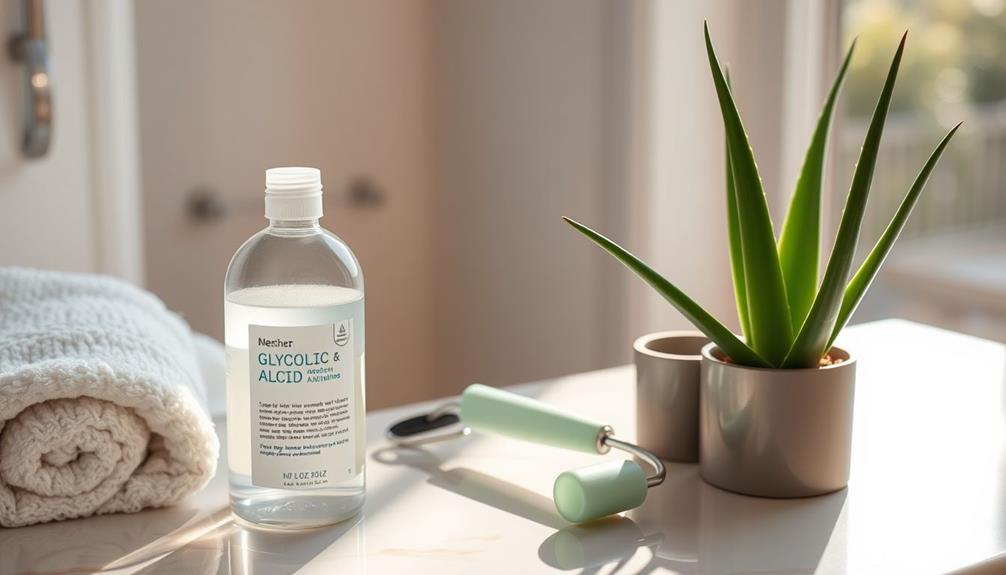
When using glycolic acid, it's essential to start with the right frequency and product type for your skin's needs.
You should also prioritize patch testing to avoid any unwanted reactions.
Understanding these key points will help you incorporate glycolic acid safely and effectively into your skincare routine.
Application Frequency Guidelines
To effectively incorporate glycolic acid into your skincare routine, start with a low concentration and gradually increase usage based on your skin's tolerance.
Begin with around 5% glycolic acid and use it two to three times a week. This approach helps your skin adjust and minimizes the risk of skin irritation.
For optimum results, apply glycolic acid products at night to reduce sun sensitivity, and don't forget to follow up with a broad-spectrum sunscreen during the day.
Avoid using glycolic acid on the same days as other strong exfoliants or active ingredients, like retinoids. This can prevent over-exfoliation and skin irritation.
Monitor your skin's response closely; as your skin adapts, you might increase the application frequency to every other day or even daily.
However, keep in mind that at-home products should typically not exceed 10% glycolic acid. For more significant results, consider professional settings where chemical peels containing higher concentrations are available.
Always prioritize your skin's health and adjust usage accordingly to achieve the best results without compromising your skin tolerance.
Product Types Available
Glycolic acid comes in several product types, including cleansers, toners, serums, creams, and professional chemical peels, each designed to address specific skin needs.
For at-home use, look for OTC products with lower concentrations of glycolic acid, generally up to 10%. Starting with a glycolic cleanser or a serum around 5% is a smart strategy; it helps you gauge your skin's tolerance before moving on to higher concentrations.
You can incorporate these products into your routine by applying them at night. This timing minimizes sun sensitivity and allows your skin to absorb the benefits while you sleep. After using glycolic acid, always follow up with a hydrating moisturizer to support your skin barrier function.
If you're considering glycolic acid peels, remember that these professional treatments offer higher concentrations for more significant results but should be approached with caution.
Each skin type reacts differently, so it's essential to choose the right product type that suits your needs. Always prioritize patch testing before full application to avoid any adverse reactions, especially if you have sensitive skin or pre-existing conditions.
Patch Testing Importance
Before fully incorporating glycolic acid into your skincare routine, patch testing is key to guaranteeing your skin can tolerate the ingredient without irritation. This simple step can help you avoid adverse reactions and guarantee a smoother experience with glycolic acid.
Here's how to effectively perform patch testing:
- Select a discreet area: Apply a small amount of glycolic acid on the inner forearm or behind the ear, as these areas are less visible and sensitive.
- Observe for 24-48 hours: After application, wait to see if any irritation, redness, or allergic reactions occur. This timeframe allows you to gauge your skin tolerance.
- Start with lower concentrations: If you have sensitive skin, beginning with lower concentrations can help minimize the risk of irritation.
- Gradually incorporate: If no adverse effects are noted, gradually incorporate glycolic acid into your skincare routine, increasing frequency as your skin adapts.
Suitable Skin Types

Individuals with normal, combination, and oily skin will likely benefit most from glycolic acid's exfoliating properties. This powerful alpha hydroxy acid effectively clears clogged pores, helping to prevent breakouts and improve skin texture. If you have oily skin, you'll find it particularly useful in controlling excess sebum production.
While glycolic acid can be effective for acne-prone individuals, those with dry or sensitive skin should proceed with caution. You may experience irritation, so starting with lower concentrations is advisable. It's also essential to take into account your skin type and seasonal changes; winter dryness can affect tolerance, making it important to adjust your usage accordingly.
For those with darker skin tones, be mindful of the risk of post-inflammatory hyperpigmentation. Always perform patch tests before incorporating glycolic acid into your routine.
Regardless of your skin type, using sunscreen is vital when using glycolic acid, as it increases your skin's sensitivity to UV rays. Protecting your skin from sun damage is essential, ensuring you reap the benefits of glycolic acid without compromising your skin's health.
Possible Side Effects
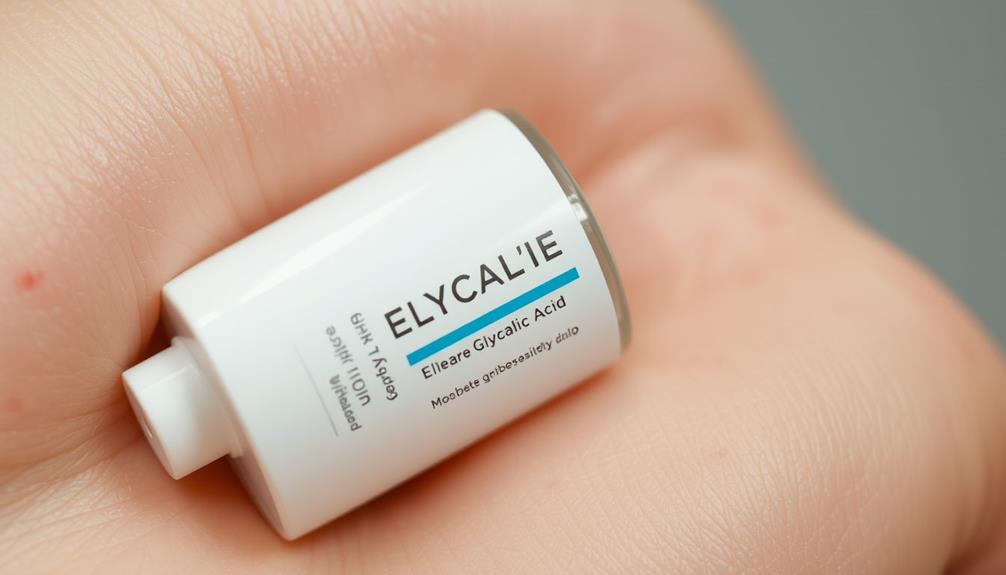
What should you expect when using glycolic acid? You might encounter side effects like skin irritation, redness, or a burning sensation, especially if your skin is sensitive. Here are some potential side effects to keep in mind:
- Skin Irritation: You may experience redness, itching, or swelling. This is common with the exfoliating effects of glycolic acid.
- Peeling and Dryness: As your skin adjusts, expect some peeling and dryness, particularly during the initial use.
- Increased Sensitivity: Glycolic acid can make your skin more sensitive to the sun. It's essential to apply sunscreen daily to protect your skin.
- Hyperpigmentation: In rare cases, stronger concentrations may lead to hyperpigmentation in sensitive skin types, so proceed with caution.
Avoid applying glycolic acid to broken skin, as this can exacerbate irritation and increase the risk of a burn.
Always listen to your skin; if you notice persistent discomfort or adverse reactions, consider adjusting your usage or consulting a professional.
Expert Recommendations
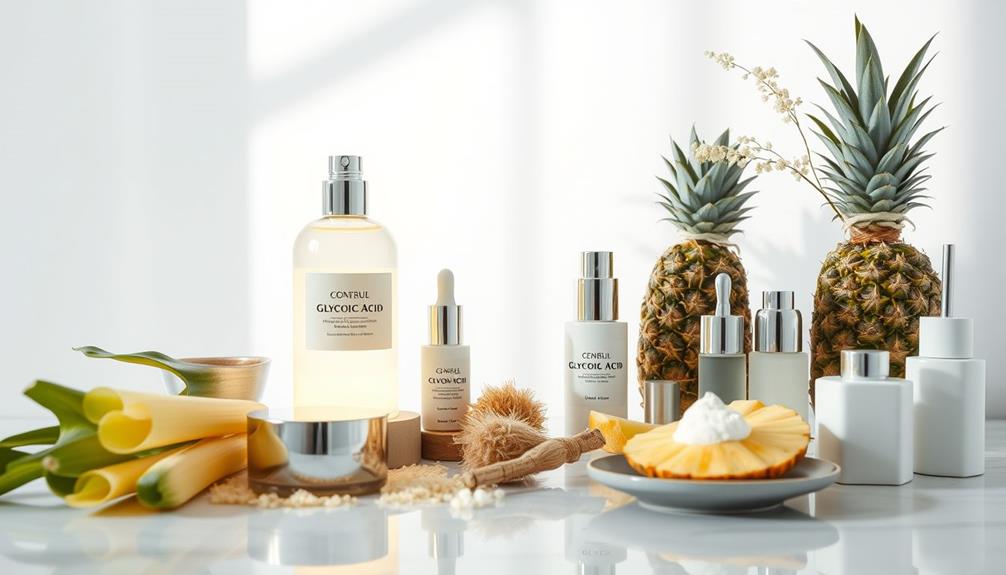
Dermatologists often recommend starting with lower concentrations of glycolic acid to help your skin adjust and minimize irritation. If you have sensitive skin, begin with a product containing 5-10% glycolic acid. This approach allows you to gradually increase usage as your skin builds tolerance.
Incorporating glycolic acid into your nighttime skincare routine is ideal, as it can enhance sun sensitivity. Always apply broad-spectrum sunscreen during the day to protect your skin.
For those looking to improve skin texture and tone, glycolic acid is an excellent choice due to its exfoliating properties and ability to stimulate collagen production. If you're considering more significant results, such as addressing acne scars or hyperpigmentation, professional-grade peels can be effective options.
Before diving into any new glycolic acid products, remember the importance of patch testing. This step helps you identify any potential adverse reactions, ensuring a smoother experience when you start using the product fully.
Conclusion
Incorporating glycolic acid into your skincare routine is like giving your skin a rejuvenating wake-up call.
Just as a morning coffee can boost your energy, glycolic acid revitalizes your complexion, revealing a brighter, smoother surface.
Remember to start slow and listen to your skin, treating it with the care it deserves.
With consistent use, you'll notice a transformation that's not just skin deep—it's a confidence boost too.
Go ahead, release your glow!

